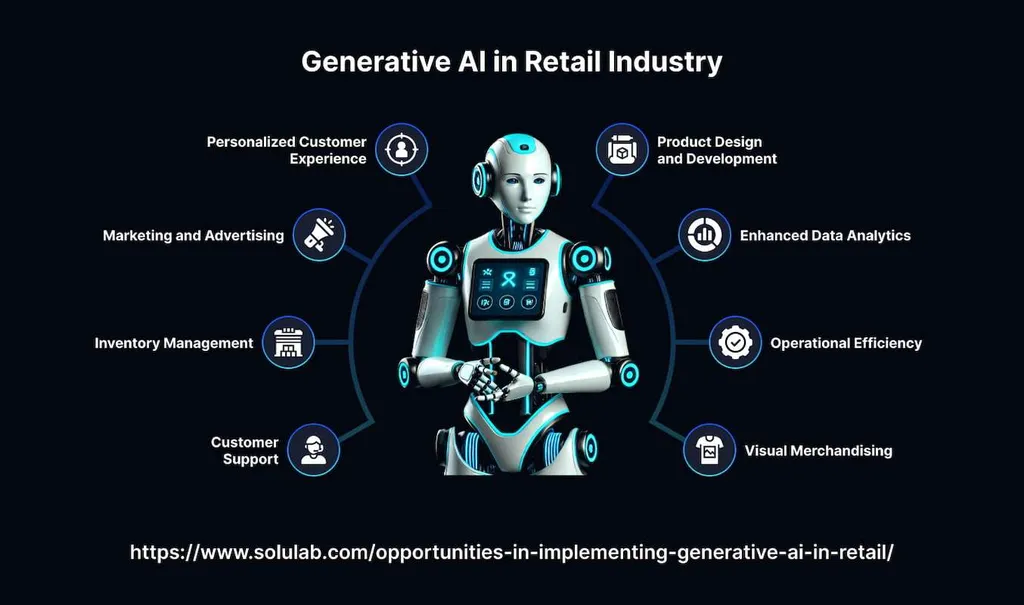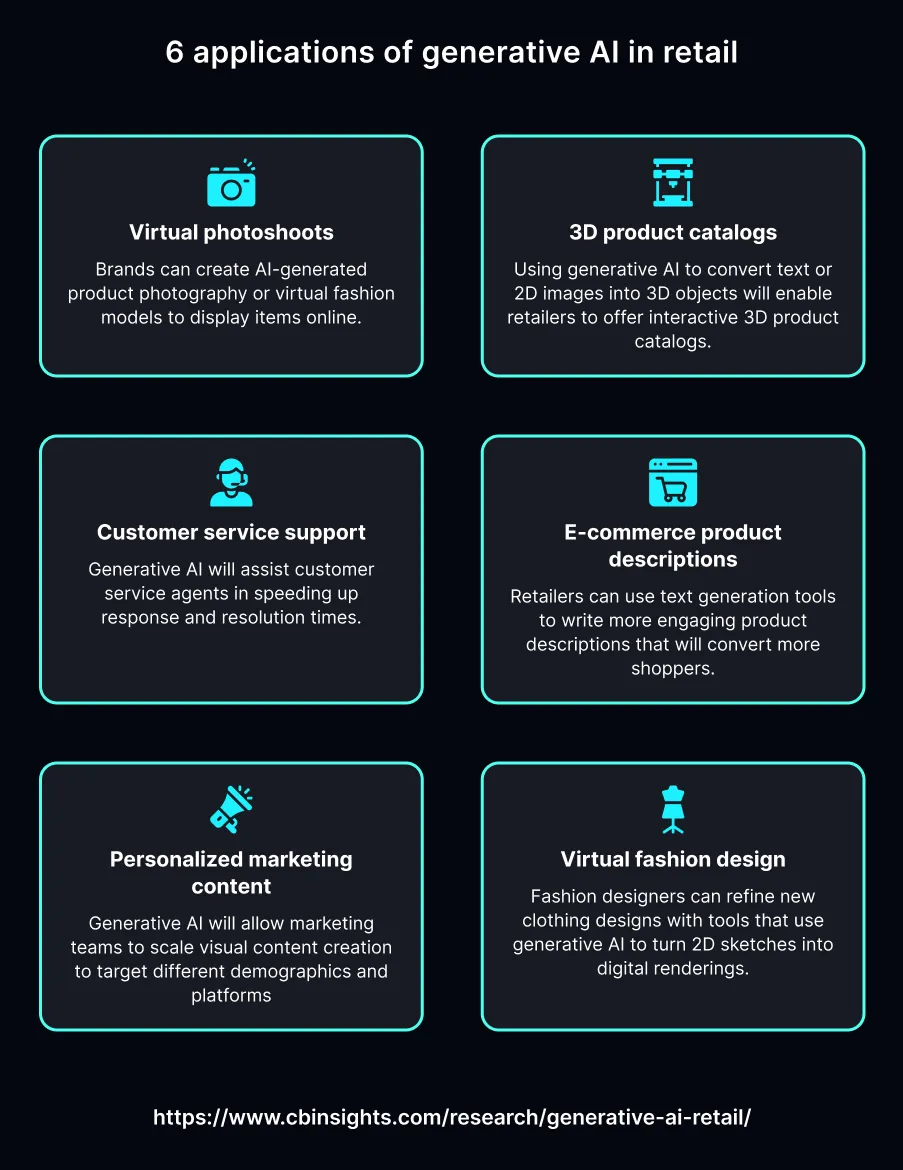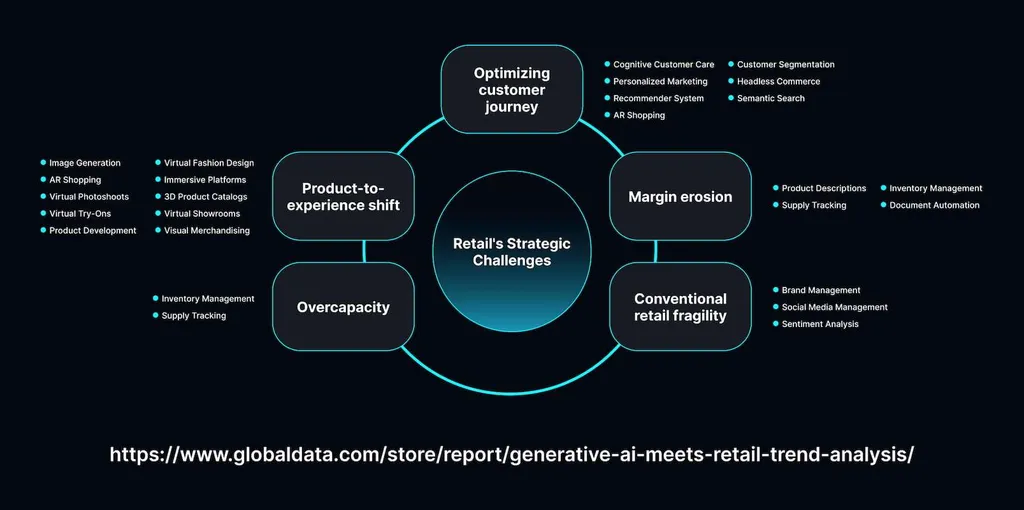The development of artificial intelligence (AI) technology has fully transformed the retail industry. Businesses utilize algorithm-based solutions to enhance customer experience (CX) and optimize operations. Early adopters benefit from increased ROI, as AI tools facilitate inventory management, streamline logistics, and expedite solving client requests. Companies should learn about the potential of this technology to make AI systems an integral part of their workflows. In this guide, we will examine the significance of generative AI for retail and analyze how entrepreneurs utilize virtual assistants, chatbots, and other AI-powered tools to build loyalty and increase satisfaction levels.
What is the Role of Generative AI in Retail?
Using gen AI in retail allows employees to streamline processes and make the shopping experience more enjoyable for buyers. Every business that wants to achieve sustainability in the long term should consider the most recent technological shifts. Adopting innovative solutions early gives companies an advantage over competitors. As 82% of enterprises that utilize AI believe it will fully transform their industries, embracing this technology is paramount.
The deployment of algorithm-based tools with legacy systems facilitates processing large volumes of data, detecting behavior patterns, noticing early signs of dissatisfaction, and offering recommendations tailored to a client’s needs. Large Language Models (LLMs) are trained on high-quality datasets provided by retail companies, which enables AI tools to make context-relevant decisions while considering the history of past interactions.
Using AI empowers customer support (CS) teams to work more effectively. MetaDialog develops powerful AI solutions based on custom LLMs that enable businesses to automate up to 81% of replies and reduce the average resolution time to 20 seconds. With pro-grade software, companies can enhance their offerings and build loyalty to increase the number of repeat purchases.
Benefits of Generative AI in Retail
Even though some companies have started to recognize the upsides of implementing AI, the widespread adoption of this technology is still hindered by mistrust. However, businesses gradually start to see value in such tools. Let’s consider the main advantages of AI:
- Streamlined functionality: AI simplifies achieving a resolution. Algorithm-driven tools are extremely intuitive, which allows retail employees to utilize them with little to no experience. Even though training sessions are necessary for those professionals who work with datasets and build LLMs, CS specialists can figure out how to utilize such tools quickly. Besides, customers find it easy to interact with virtual assistants. They just need to provide a short text prompt to get a well-written reply, generate an image of them wearing a specific clothing item, or get a product recommendation.
- No delays: AI agents, bots, and services are available 24/7. They provide timely responses regardless of the season or the time of the day. The implementation of the solutions developed by MetaDialog can boost a CS team’s productivity by 5 times as they cope with increased workload perfectly. In addition, AI products enable retail businesses to expedite sales and achieve R&D goals within a shorter timeframe.
- Strong relationships with the target audience: By segmenting the clientele and offering tailored recommendations, AI tools make marketing efforts more result-yielding and increase ROI. Task automation enables employees to focus on top-priority requests from customers who are likely to finalize a purchase. AI systems analyze information about a client’s preferences and remember past conversations, which enables them to reduce dissatisfaction and generate relevant responses.
Retail businesses utilize AI to create a frictionless CX and eliminate barriers that prevent buyers from finalizing purchases.
How Generative AI Transforms Retail

Hyper personalization is one of the most noticeable recent AI trends in retail. It continues to shape the industry. With 91% of consumers stating they are more inclined to shop at stores that offer relevant recommendations, enhancing CS agents’ ability to analyze clients’ preferences becomes pivotal. This is where AI models come in handy. They facilitate cross-channel selling, expedite shopping, and allow buyers to get custom offerings.
Automated systems make it possible to open autonomous eCommerce stores, offer on-demand delivery options, and integrate virtual shopping assistants trained to recognize intent and analyze huge datasets. Surpassing buyers’ expectations is the only way to gain trust and win loyalty. Below, we have analyzed the main application of artificial intelligence in retail.
Content generation
AI tools enable brands to generate engaging content at a low cost. AI services create prototypes and produce top-level content without wasting time. Companies produce custom content relevant to the needs of specific audience segments to drive engagement and boost conversions. With AI systems, one may create all types of content, from detailed product descriptions to enticing catalog images.
Interactive experience
Consumers value an opportunity to communicate with personal stylists. AI bots serve the same purpose and enable clients to discover the products they need. They remember information about preferences and find listings that may prompt buyers to make a spontaneous purchase.
By making product recommendations personalized, retailers can build a solid client base and influence consumers’ shopping decisions. Traditional search features quickly become obsolete, as 1 in 10 buyers complain they cannot find a suitable product when browsing catalogs. Deploying algorithm-driven tools facilitates item discovery and enables clients to interact with virtual stylists trained to provide a top-level shopping experience.
Catalog management
Businesses do not have to create and update product catalogs manually if they use AI systems. Automated tools enable users to produce studio-level pictures using text prompts, organize listings by categories, and generate marketing materials. There is no need to wait for weeks trying to get the ordered images from studios. Sorting listings also became easier due to the usage of algorithms.
As 92% of potential customers are more likely to purchase a product if they can find it quickly, streamlining the UI of an eCommerce website and making it easier to navigate is a must. AI services improve websites’ searchability and ensure that catalogs will be regularly updated, which improves shoppers’ experience.
Expedited product development
Deploying AI speeds up project completion and allows businesses to achieve the set goals while staying within budget. Algorithm-powered features foster research and enable employees to discover valuable insights by comparing multiple sources. The LLM’s ability to analyze large data volumes enables firms to minimize product R&D expenses and discover the most lucrative development opportunities.
LLMs facilitate audience research and enable companies to come up with attention-grabbing packaging designs. Thus, using AI-based models reduces time-to-market and ensures no inconsistencies will be found in a product after a release.
CS automation
AI systems quickly became an integral part of CS teams’ processes. They enable agents to provide accurate replies in real time, focus on top-priority leads, process basic queries without delays, and search through extensive knowledge bases. Moreover, AI bots streamline other workflows as well. They reduce the contact center’s workload, provide summaries of past conversations, process customer data, and update the FAQ section.
As 75% of buyers use multiple channels when communicating with brands, AI models enable retailers to provide top-level services across multiple touchpoints, including call centers and social media platforms. AI assistants provide instant, natural-sounding replies automatically, enabling buyers to find the answers they are looking for.
Real-World Applications of Generative AI in Retail

Major brands were quick to recognize the upsides to deploying AI bots. They utilize generative AI to fully transform CX and build strong relationships with buyers. Wendy provided one of the first examples of AI usage by using this technology to streamline the functioning of takeout windows in Ohio. This step has significantly improved the buyer’s experience and boosted the popularity of the fast-food company’s offerings.
The Estée Lauder Companies Inc. has also decided to integrate AI tools to enhance online shopping experiences. The ability to spot trends using AI helped it become the beauty industry leader and grab investors’ interest. Here are some other examples of successful implementation of AI products:
- Walmart: With remote employees, the company decided to deploy virtual assistants to increase their efficiency. Retail chatbots facilitate solving time-consuming tasks. The retailer also plans to add AI features to its platform to facilitate access to information.
- Amazon: The company has been looking for ways to enhance CX and minimize the number of complaints. Using AI, it started to generate client review summaries to help potential buyers make up their minds about a purchase. This approach demonstrated impressive efficiency. It saves clients a lot of time and allows them to make decisions based on actual feedback. The in-built service analyzes reviews, selects the main themes, and generates a short summary based on the collected insights. It enables buyers to learn about a product’s pros and cons without scrolling through hundreds of entries in the review section.
- eBay: This online shopping platform hosts third-party sellers who can now list their products in no time by uploading product photos. The integrated AI feature scans the pics and automatically compiles enticing descriptions with titles, product details, and availability dates. This option is especially useful for sellers who need to upload many listings and describe them with high accuracy to avoid disputes and returns.
Even though many retailers have started to develop unique AI features, only some are ready to openly discuss the responsible use of this technology. Walmart was a notable exception, as the company has developed a clear policy based on six principles of ethical AI tool deployment. It strives to use algorithm-driven solutions for consumer benefit while protecting client data. Other retailers are expected to follow suit and adopt similar policies, which are bound to expedite AI adoption.
Challenges of Implementing Generative AI in Retail

Even though many industry leaders successfully implemented AI solutions, the integration of such tools requires a careful approach. Disregarding the risk associated with the technology may lead to customer data breaches and severely damage a company’s reputation. In addition, businesses should hire experienced developers with advanced skills and strong technical backgrounds who are ready to integrate AI models with legacy systems.
Building LLMs from scratch and integrating them into current workflows is arduous and time-consuming. It necessitates learning more about possible threats every retailer should consider:
- Difficulties with acquiring high-quality training data: Unless a retailer already utilizes pro-grade solutions trained to collect buyers’ information and analyze their past behavior, it may be impossible to create reliable datasets to train AI models.
- Incompatibility with the existing infrastructure: Many companies use outdated software and rely on time-tested solutions, failing to recognize the necessity of upgrading their systems and processes. Before selecting an AI tool, it is pivotal to analyze whether it can be integrated with other solutions used by employees.
- Low skill level: It won’t suffice to demonstrate the importance of generative AI for retail without upskilling CS agents, engineers, and other employees to achieve tangible results.
- Unbalanced approach: Some retailers are quick to believe in the power of AI automation and fire workers. As a result, CX suffers, as some problems require adding a human to the loop. Besides, only human employees can control the usage of LLMs and suggest tweaks to improve their performance.
- Data breaches and biases: When buying products from brands, consumers need to know their information is securely protected. A retailer must comply with privacy regulations when collecting customer data and deploying AI services. In addition, strict guidelines should be adopted to guarantee AI models won’t demonstrate a biased approach.
Despite these issues, the usage of AI shopping solutions is expected to increase. Using a reputable service provider allows retailers to avoid these threats when building and integrating AI tools. MetaDialog’s experts build fully compliant on-premises LLMs with advanced security features, which ensures the safety of user data.
How to Get Started With Generative AI in Retail
After analyzing the strengths and weaknesses of the innovative approach that involves integrating AI models into retail platforms, firms can make an informed choice.
Those who want to utilize AI to improve ROI and generate lasting value for their clientele need to devise a viable strategy encompassing all the stages of the implementation process, from developing to deploying AI features.
Follow these steps to implement AI tools:
- Learn about the potential of generative AI: Focusing on the target audience’s needs allows companies to discover how the technology can be used to scale operations. It’s also crucial to collect information about training LLMs, possible challenges a firm may face during implementation, and the most successful examples of deploying such products. For instance, Airbnb was the first to discover some innovative areas of applying Gen AI when it discovered inconsistencies in property listings and decided to personalize UX.
- Focus on specific use cases: After identifying the areas that require improvement, a company should analyze its technical resources, datasets, and capabilities. Retailers may adopt a modern data management approach to collect and organize data. A SWOT analysis helps an enterprise discover whether it mitigates threats and capitalizes on its strengths. Generative AI tools help organizations learn about the practical application of artificial intelligence models in a specific area. After detecting pain points and discovering core strengths, it’s time to move to the next stage.
- Devise a technology-based strategy: Identifying issues lets firms set achievable goals. A retailer should estimate the technical skills needed to implement a specific solution, consider ROI, and check whether it has the necessary data.
- Build a team: After creating a team tasked with implementation, a retailer should organize training programs to allow the employees to achieve professional growth. Finding developers with strong eCommerce backend skills is challenging. It may be a smart idea to outsource this task to reliable AI suppliers instead.
- Develop an AI model: When a suitable technology is selected, it is possible to build pilot projects to test AI tools in a real-world environment. Monitoring the performance of AI models facilitates improving them based on customer feedback. If a project is launched successfully, a retailer may scale it to further optimize its internal processes.
As there are so many GenAI use cases, it may be daunting to choose the most suitable one. MetaDialog’s specialists consult clients on every step of implementing AI tools. They work with enterprises from different industries and come up with the most effective solutions for retail businesses that want to improve the way they serve clients.
With every year, more retailers will start to see the relevance of generative AI for retail platforms and services. Recognizing the potential of this technology early gives companies an edge over competitors and enables them to establish a noticeable presence in the industry. MetaDialog develops powerful support platforms that allow firms to automate up to 87% of queries within 1 hour. Their custom LLMs are compatible with various databases and APIs, which facilitates making them a part of an existing infrastructure. Book our free trial today and discover how to reduce expenses by developing advanced bots capable of generating human-sounding responses and increasing satisfaction.
